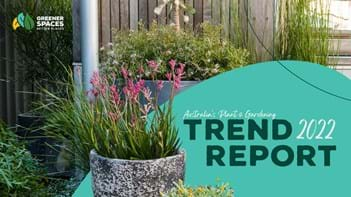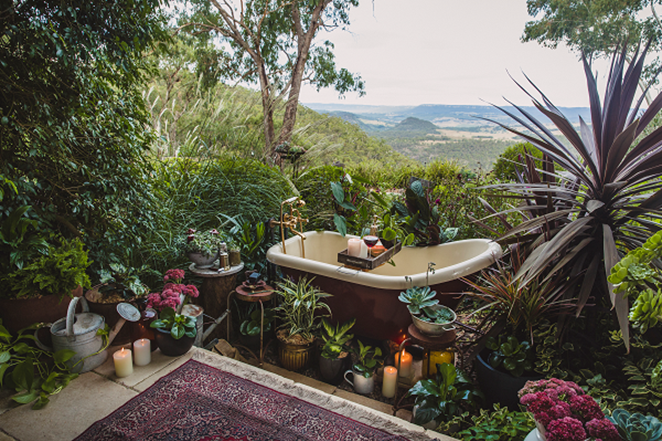New report: Australia’s plant and gardening trends
By Greener Spaces Better Places*

Greener Spaces Better Places’ 2022 Trend Report unpacks
this year’s key plant and gardening trends
(Image: Greener Spaces Better Places)
Whether home, workplace, street or suburb, Greener Spaces Better Places is on a mission to help every Australian make their space a better place. The 2022 Plant Trend Report unveils the next big gardening trends Australians are using in the face of an ever-changing climate and cost of living pressures.
It is said the only constant in life is change, and for Australians there has been a lot of change in the last year. From severe unseasonal rainfall to some of the most challenging bushfire periods in recent memory, the rise in extreme weather events linked to climate change is clearer than ever.
But the Australian love of our natural environment is not shifting. Instead, how we adapt to these bigger pressures and stay connected to the gardens that we love is changing. In the face of extremes, the optimistic Australian spirit brings out the best in us and the places we love, our home amongst the trees.
Greener Spaces Better Places has released the 2022 Plant & Gardening Trend Report - the only report of its kind in Australia. Developed through a survey of 1,600+ Australians and in consultation with nursery industry experts, thought leaders and academics across the country, the report details four key trends set to grow over the next year along with expert tips on how to bring them to life and the top performing plants to be purchased in each state.
The 2022 report reveals the majority of Australians (60%) are concerned about climate change and our environment. They are using plants to tackle this issue with plant sales up by eight percent for the year before and 2.4 billion plants sold across the country in the last year.
The trend report has found, in the face of increasing extreme weather conditions, Australians are turning to their gardens to take tangible steps to adapt and still enjoy their natural spaces. The report shows in the coming year Australians will be focused on building back habitats, beating inflation, and reaping the mental health benefits of connecting with nature.
Climate Psychologist Sally Gillespie explained the coming trends outlined in the report are clearly shaped by the climate and liveability forces around us, show a driving adaptability and a thrifty, practical, 'do-it-yourself' attitude from Australians to embrace the challenges.
“There is a tremendous sense of purpose and inspiration to heal and repair. For a good majority of people, that means being the practical gardener who pays attention, learns, plants pollinators, and gets their hands in the soil. This report clearly shows Australia’s love of the natural environment is not shifting but instead how we adapt to the bigger pressures around us - through plants and gardening - is changing.” said Gillespie.
Top four forecasted trends this year
Trend 1: Wet and wild
The prediction: Gardening to embrace the wet and promote biodiversity through wildflowers, micro wetlands, and water features.
The garden has become a hub for encouraging lively habitats, with a huge resurgence towards saving the birds and the bees – and it is not stopping anytime soon. Our nationwide obsession for green foliage has fallen from its place as the number one trend. In its place, we welcome a flurry of colour and insects as Australians take to the garden to foster a buzz.
How you can encourage your customers to bring this trend to life: Plant blue to attract bees into your garden and increase biodiversity. Choose ‘endemic’ plants that are natives local to your area and bring water into your space by building a tiered garden system.
Trend 2: Resilient roots
The prediction: Beating inflation with a low maintenance grow-your-own approach that considers water, soil, resilience, and focuses on growing and eating what’s local to Country.
The pandemic saw a boom in vegetable gardening, and people are now returning to the ‘grow it yourself movement’ in droves as extreme weather conditions push produce to unattainable prices on our supermarket shelves.
How you can encourage your customers to bring this trend to life: Use wicking beds for watering, in-garden bed worm farms for nutrients and attract beneficial predatory insects for pest management. Local plants will offer the most climate resilient and low maintenance solutions, and do not forget about healthy soil!
Trend 3: 3D greening
The prediction: Planting below, besides, and overhead to cool our homes and neighbourhoods, whilst increasing property value.
You cannot live somewhere that is too hot – period. Greening our homes and neighbourhoods with plants, shrubs, and trees, can greatly help to mitigate heat. With energy costs on the rise, more of us will be embracing the natural air conditioner of nature – planting at the base, the sides, and overhead to create cooling pockets of shade that last the long term.
How you can encourage your customers to bring this trend to life: Use deciduous vines to create a shady summer ceiling. Weave vegetable vines (such as pumpkins or zucchini) up structures to create garden ‘tents’ that cool your outdoor area.
Trend 4: Green in and zone out
The prediction: Drawing on the proven mental health benefits of plants, such as improved mood and concentration, Aussies will look to nature and the sensory experiences offered in our own gardens as a salve for eco-anxiety.
The permanent disruptions of living with a changing climate, and the temporary disruptions of living with COVID-19, are pushing us to seek solace, peace, and a quiet place just for us more than ever. Nature is a great place to zone out of the busyness and tune into a place of wellbeing and meaningful connection.
How you can encourage your customers to bring this trend to life: Escape to the garden! Plants bring direct mental health benefits such as improved mood and connection. Practise nature-based mindfulness by dropping into your five senses whilst in the garden.
For more information about these trends, read the full report by heading to the Greener Spaces Better Places website: www.greenerspacesbetterplaces.com.au > Green My Home > Latest Trends.
Follow the Greener Spaces Better Places Instagram for posts unpacking each trend: www.instagram.com/greenerspacesbetterplaces/
* Original text supplied by Belinda Bean, Greener Spaces Better Places and adapted by Gabrielle Stannus, GIA's Communications Coordinator



